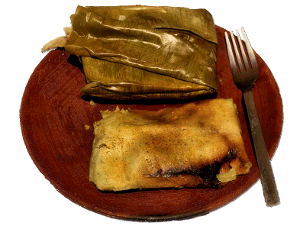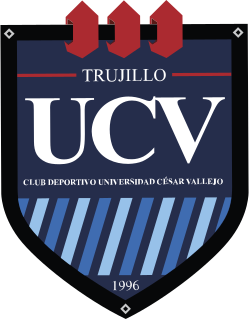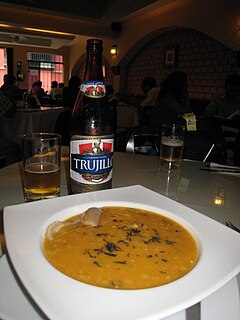
A tamale is a traditional Mesoamerican dish made of masa or dough, which is steamed in a corn husk or banana leaf. The wrapping can either be discarded prior to eating, or be used as a plate and eaten from within. Tamales can be filled with meats, cheeses, fruits, vegetables, chilies or any preparation according to taste, and both the filling and the cooking liquid may be seasoned.

La Libertad is a region in northwestern Peru. Formerly it was known as the Department of La Libertad. It is bordered by the Lambayeque, Cajamarca and Amazonas regions on the north, the San Martín Region on the east, the Ancash and Huánuco regions on the south and the Pacific Ocean on the west. Its capital is Trujillo, which is the nation's third biggest city. The region's main port is Salaverry, one of Peru's largest ports. The name of the region is Spanish for "freedom" or "liberty"; it was named in honor of the Intendencia of Trujillo's proclaiming independence from Spain in 1820 and fighting for that.

Marinera is a coastal dance of Peru. Marinera is a graceful and romantic couple's dance that uses handkerchiefs as props. The dance is an elegant and stylized reenactment of a courtship, and it shows a blend of the different cultures of Peru. The dance itself has gained a lot of recognition and is one of the most popular traditional dances of Peru. The city of Trujillo has been the national capital of this dance ever since the passage of law No. 24,447 on January 24, 1986. The Trujillo Marinera Festival has been held in Trujillo since the 1960s. In 2012, the Congress of the Peruvian Republic declared October 7 as Marinera Day in Trujillo City, which is celebrated with a parade and dance expressions.

Huanchaco is a popular vacation beach town in the city of Trujillo, Peru. Huanchaco is known for its surf breaks, its caballitos de totora and its ceviche, and is near the ancient ruins of Chan Chan. Huanchaco was approved as a World Surfing Reserve by the organization Save The Waves Coalition in 2012 This historic town is part of the tourist circuit called the "Moche Route" or "Ruta Moche".

King Kong is a Peruvian cuisine dessert. It is made of cookies, filled with Peruvian blancmange, some pineapple sweet and in some cases peanuts, with cookies within its layers. It is sold in one-half and one kilogram sizes. It is known as part of the culture of Lambayeque Region and nowadays the makers of the dessert are grouped in the King Kong and Typical desserts Producers Association of Lambayeque City.
Peruvians of European descent, also known as White Peruvians. An outside estimate gives 15% of the total population. Traditionally, this group has been more dominant in the political, commercial, and diplomatic sectors of Peruvian society. According to the most recent 2017 census where Ethnic Self-identification was used, it makes up about 5.9% of the total population aged 12 yrs and above of Peru.

Club Deportivo Universidad César Vallejo is a Peruvian football club located in Trujillo. The club was founded on January 6, 1996 and was promoted in 2003, through the Copa Perú, to the Peruvian First Division and relegated in 2005. In 2007, they were Segunda División champions and were promoted to the first division again.

Víctor Larco Herrera also called commonly Víctor Larco is a district and a city of the north coast of Peru, is located on a plain along the Pacific Ocean and is linked by a conurbation with Trujillo city in La Libertad region, is considered one of the 9 districts of the urban area known as Trujillo Metropolitano, one of the most populous metropolitan areas of Peru; it is also one of the 11 districts of Trujillo province. Victor Larco is the district that has the highest human development index (HDI) out of Lima Metropolitana, according to a study published by the United Nations Development Programme. In the early twentieth century, for its mild climate and fresh, it was known as Buenos Aires and then in 1945 got the name of Victor Larco Herrera in memory of the illustrious philanthropist Trujillan who was a benefactor of the city.

San José Festival is a peruvian patronal feast, it is held in the resort called Las Delicias beach in the district of Moche near Trujillo city and the central day is 19 March, the celebrations last a week more or less; these days are of feast and it has been a tradition with a strong Spanish influence, which are enjoyed various activities for adults, youth and children, party hosts are Don Jose and Doña Josefa and Ms Maja, the event begins with the description of characters, activities, bars, flamenco dancing, etc.; This festival is accompanied by a procession of the patron Saint Joseph, the fashion show, the bullfighting, the parade of characters, and toromatch pamplonada in which involved several teams from other regions of the country. Some houses are become in Spanish bars decorated with motifs like flags, grimaldas and posters.

Santiago de Huamán is a traditional village of Trujillo, Peru; it is located on the west of the city in Víctor Larco Herrera. Currently its main attractions are the church, baroque style, and the Patron Festivities that are held every year in May or June.

Competition of Paso Horses in Trujillo is a contest held in Trujillo city located at northern Peru. These competitions organized by the Association of Breeders and Owners of Paso Horses in La Libertad have as principal participants to the traditional Chalanes (riders) and Peruvian Paso horses in the city are celebrated annually. The care and training of Paso horses in this place is a very old tradition. Trujillo is known and considered as the Cradle of the typical Peruvian Paso Horse as well as the Capital of Culture of Peru so as the Capital of the Marinera dance, which is one of the most important cultural symbols in Peru.

The Foundation of Trujillo is an example of Spanish colonial expansion that took place in the area known today as the Valley of Moche in northern Peru. The exact date of Trujillo's foundation is still in dispute; according to historian Napoleón Cieza Burga it is November 1534.
Caja Trujillo, is a Peruvian banking company centered in Trujillo city in the financial sector and currently It is the largest financial company locally, began to operate and provide services in 1985. Up to year 2012 this company has agencies service installed in different regions of the coast and highlands of the Peru providing financial attention mainly to small and medium entrepreneurs in the SME sector. According to a study published in 2010 by the magazine Peru Económico it is one representative mark of the city.
Dulcería Castañeda, is a traditional company and brand of candy in the Peruvian city of Trujillo. Since year 1925 traditionally this company made several kind of candies called alfajors and specially that giant candy called "Alfajor king kong" before known as Alfajor de Trujillo, "Dulcería Castañeda" currently has several local in Trujillo also in Lima city. Its main products are the alfajores requested by tourists as classic sweet souvenirs of the city of the everlasting spring. According to a study published in 2010 by the magazine Peru Económico this is one of the top ten brand of the city.
Alfajor de Trujillo is a typical kind of alfajor from Trujillo, a Peruvian city. The alfajor de Trujillo is manufactured since old times and has several layers and it can be of different sizes and shapes as round or square. It is made mainly with products as flour, butter, eggs and milk, filled with milk candy, some pineapple sweet and in some cases peanuts, with cookies within its layers. The most famous company manufacturing this products in Trujillo is Dulcería Castañeda. It is one of the products presented in the Gastronomic Fair in Trujillo.















